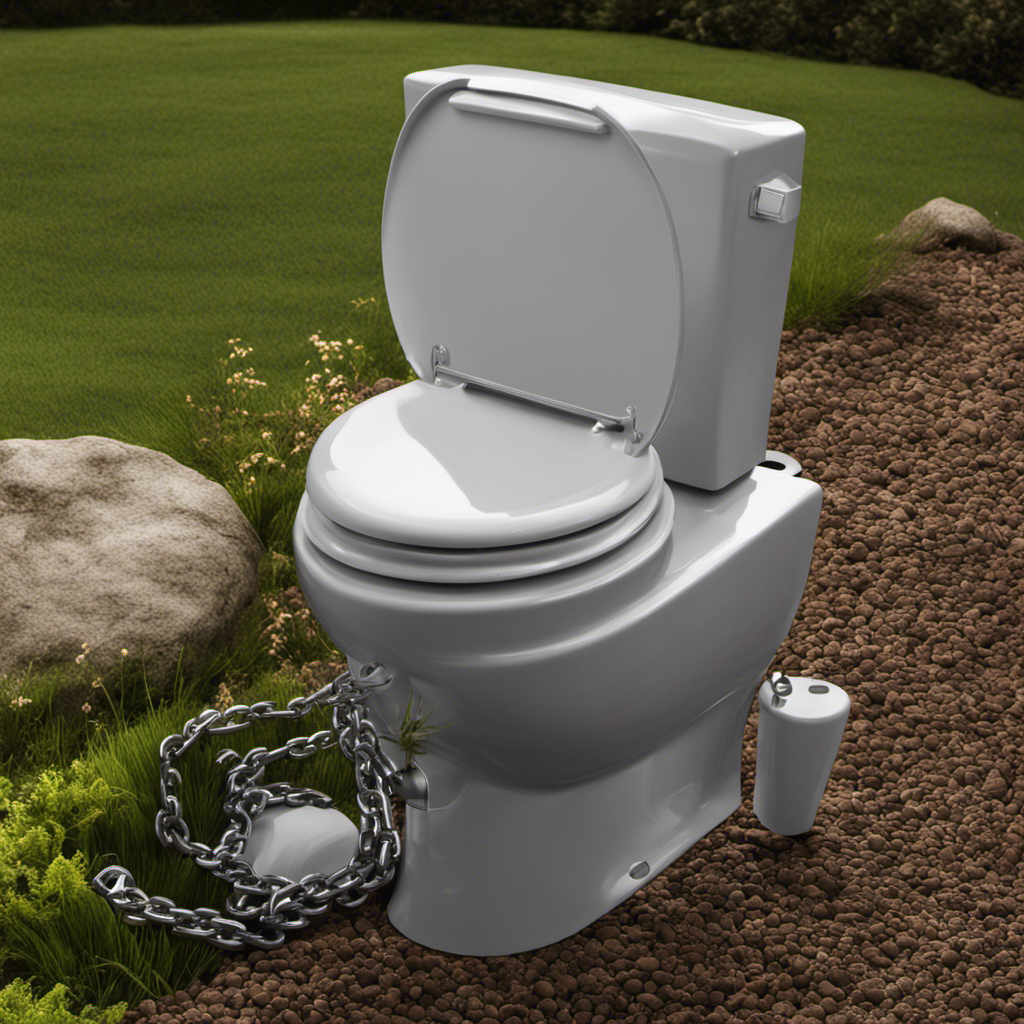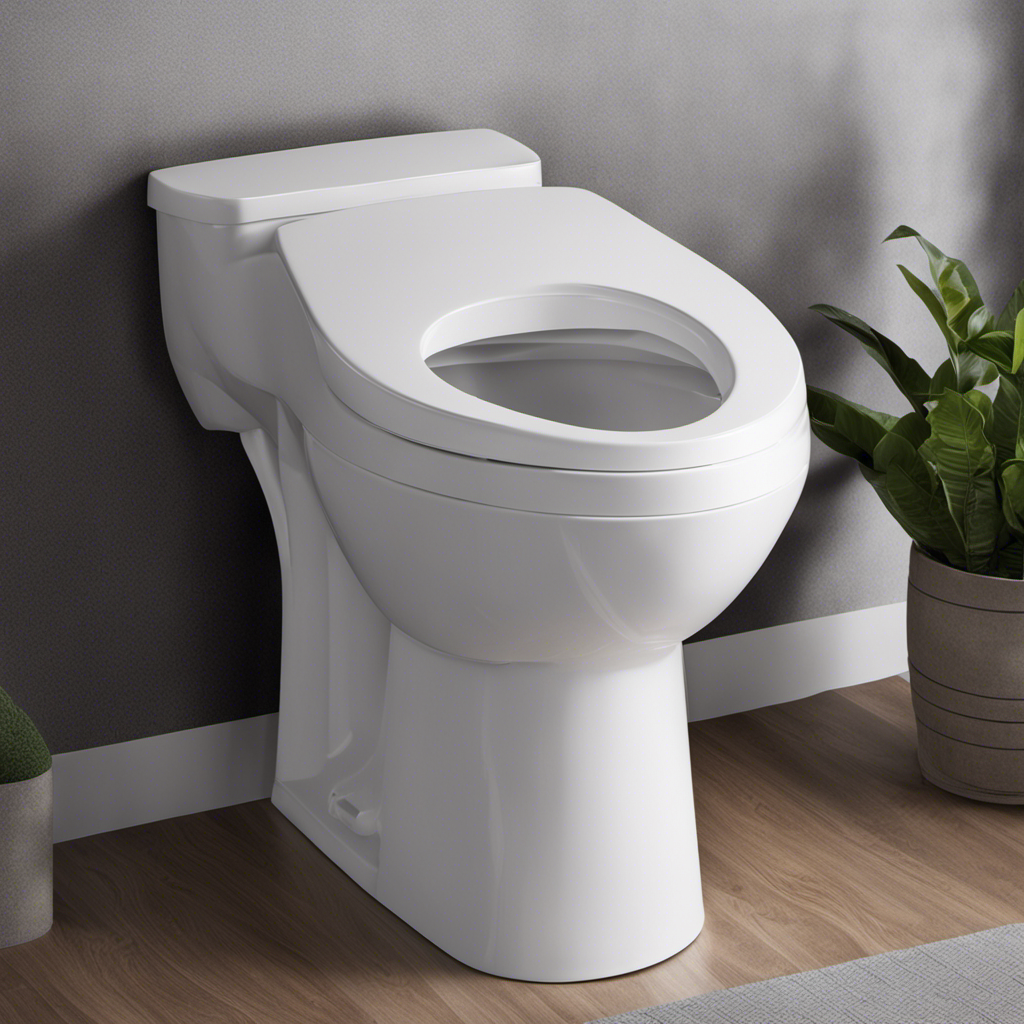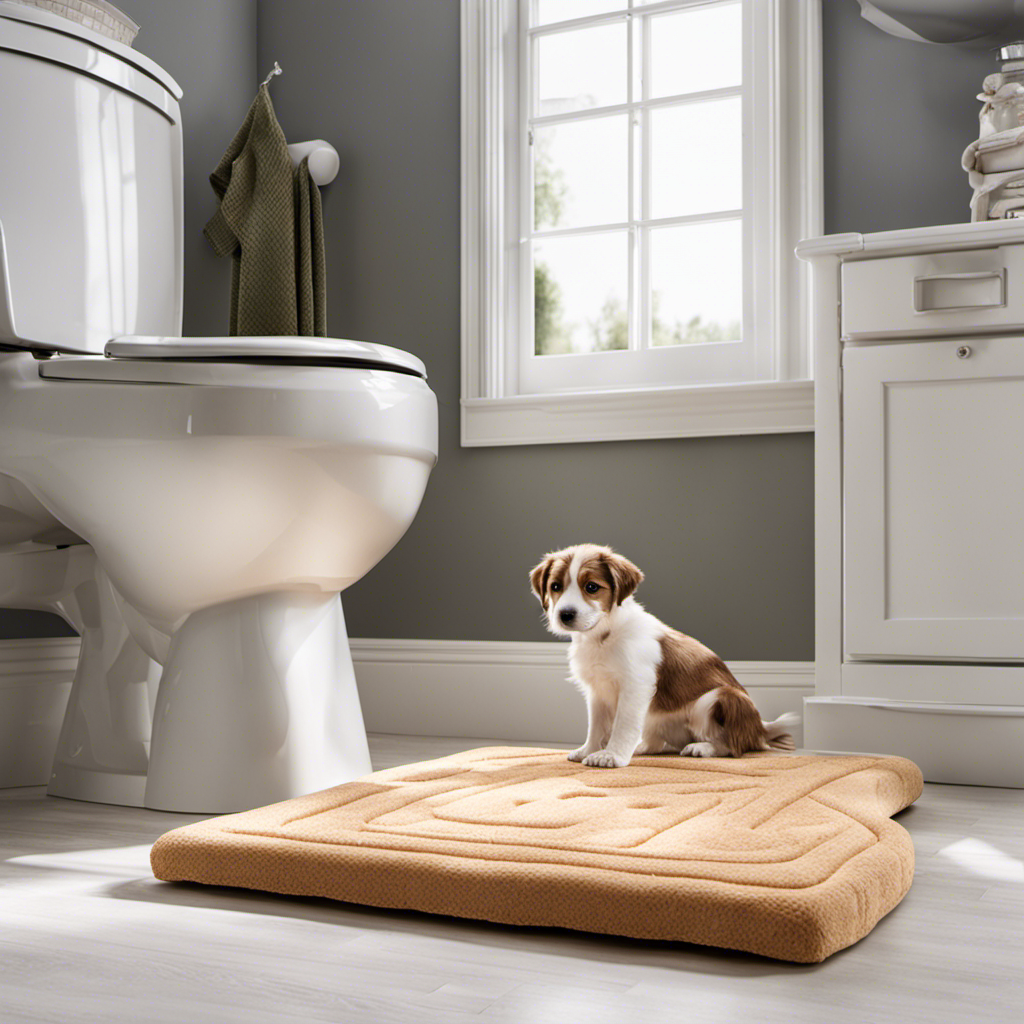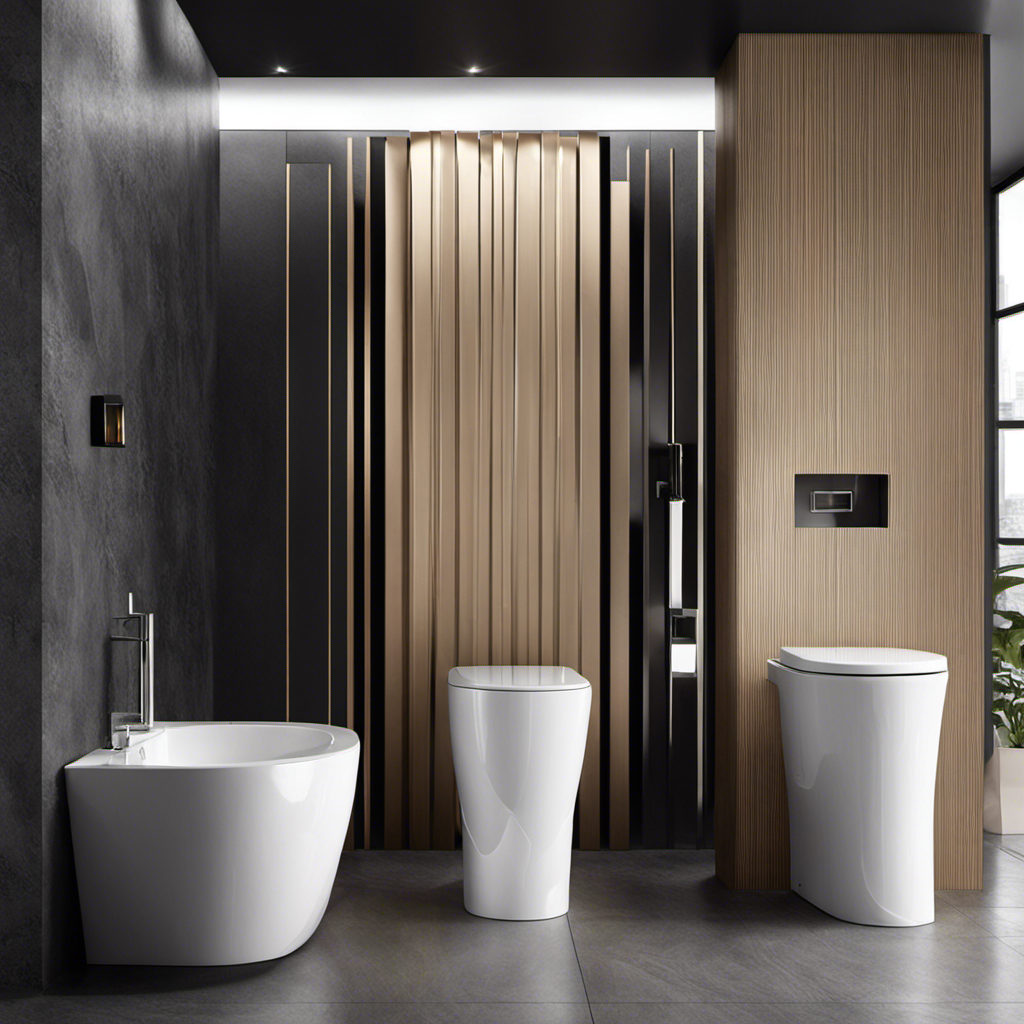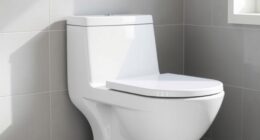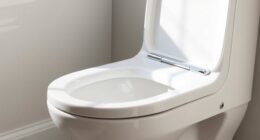I’ve always heard that knowledge is power, so let’s dive into the fascinating world of toilet flappers.
You may have never given them much thought, but these small devices play a crucial role in the functioning of your toilet.
In this article, we’ll explore the function of a toilet flapper, discover the different types available, learn how to identify signs of a faulty flapper, and even explore tips for maintaining and upgrading this essential component.
Get ready to become a toilet flapper expert!
Key Takeaways
- The toilet flapper controls the flow of water in the toilet bowl and seals the opening at the bottom of the tank.
- Regular inspection and replacement of the flapper is important for proper functioning.
- Different types of flappers, such as rubber, silicone, and chain-and-flapper assemblies, offer varying benefits and suitability for different toilets.
- Signs of a faulty flapper include leaking water supply, incomplete flushes, constant running water, and high water bills. Troubleshooting and maintenance can help identify and fix flapper issues.
The Function of a Toilet Flapper
The toilet flapper controls the flow of water in the toilet bowl. It is a small rubber or plastic valve that seals the opening at the bottom of the tank.
When you flush the toilet, the flapper lifts up, allowing water to rush into the bowl and create a powerful flush. Once the tank is empty, the flapper drops back down, sealing the opening and preventing any more water from entering the bowl.
Maintaining the toilet flapper is crucial for the proper functioning of your toilet. A malfunctioning flapper can lead to water leakage, inefficient flushing, and higher water bills. Regular inspection and replacement of worn-out flappers can help ensure a properly functioning toilet.
Now, let’s explore the different types of toilet flappers.
Different Types of Toilet Flappers
One of the main types of toilet flappers is the rubber flapper, which is commonly found in most toilets. Rubber flappers offer several advantages over other materials, making them a popular choice for toilet manufacturers and homeowners alike.
Advantages of rubber flappers:
-
Durability: Rubber flappers are highly resistant to wear and tear, ensuring long-lasting performance.
-
Flexibility: The rubber material allows the flapper to create a tight seal, preventing water from leaking out of the tank.
-
Cost-effective: Rubber flappers are affordable and readily available, making them a cost-effective option for toilet repairs and replacements.
Rubber flappers are typically made from high-quality synthetic rubber, which provides excellent sealing properties and resistance to chemicals commonly found in toilet water. This material ensures that the flapper remains effective and reliable for years to come.
Signs of a Faulty Toilet Flapper
When it comes to a faulty toilet flapper, there are several key signs to look out for.
One of the most common issues is a leaking water supply, which can lead to wasted water and increased utility bills.
Another indicator is incomplete flushes, where the toilet does not properly flush all waste down the drain.
Lastly, constant running water is another sign of a faulty flapper, indicating that the flapper is not sealing properly and allowing water to continuously flow into the toilet bowl.
Leaking Water Supply
If your toilet is leaking water, it could be due to a faulty toilet flapper. The toilet flapper is responsible for controlling the water flow from the tank into the bowl. When it malfunctions, it can cause water to continuously leak into the bowl, leading to wasted water and higher water bills.
There are several reasons why a toilet flapper may leak water.
-
Inadequate water pressure: If the water pressure in your plumbing system is too high, it can put excessive strain on the toilet flapper, causing it to leak. It is important to check the water pressure and adjust it if necessary.
-
Flapper deterioration: Over time, the materials of the toilet flapper can degrade due to mineral deposits, chemicals in cleaning products, or general wear and tear. This can lead to leaks as the flapper loses its ability to create a watertight seal.
-
Incorrect flapper installation: If the toilet flapper is not installed correctly or is the wrong size for your toilet, it may not seal properly and result in water leakage. It is crucial to ensure that the flapper is installed correctly according to the manufacturer’s instructions.
Incomplete Flushes
To prevent incomplete flushes, make sure the water pressure is adequate and the flush mechanism is functioning properly.
If you’re experiencing incomplete flushes, it could be due to a faulty toilet flapper. The flapper is a rubber valve that controls the flow of water from the tank to the bowl during flushing.
Over time, the flapper can become worn or misaligned, causing water to leak from the tank and preventing a complete flush. To troubleshoot this issue, first, check the flapper for any visible signs of damage or debris. Clean or replace the flapper if necessary.
It’s also important to ensure that the flapper is properly seated on the flush valve opening. By maintaining and troubleshooting your toilet flapper, you can ensure a complete and efficient flush every time.
Now, let’s move on to the next section about constant running water.
Constant Running Water
The most common cause of constant running water in a toilet is a faulty fill valve. When the fill valve doesn’t work properly, water continuously flows into the tank, causing it to constantly refill. This not only wastes water but also leads to higher water bills.
To address this issue and promote water conservation, it is important to identify and fix the problem. Here are three steps to help you troubleshoot and resolve the constant running water in your toilet:
- Check the fill valve for any signs of damage or wear.
- Adjust the float arm or water level to ensure it is at the correct height.
- Clean or replace the fill valve if necessary.
How to Replace a Toilet Flapper
When it comes to toilet flappers, there are a few common issues that can arise. These include leaks, improper seating, and wear and tear.
In order to address these problems, proper flapper installation is crucial. In this discussion, I will delve into the common flapper issues that homeowners may encounter and provide detailed instructions on how to correctly install a toilet flapper.
Common Flapper Issues
One common flapper issue is that it doesn’t create a tight seal, causing water to continuously leak from the toilet tank. This can be a frustrating problem, but with proper toilet flapper maintenance and troubleshooting, it can be resolved.
Here are three common flapper issues and their solutions:
-
Flapper deterioration: Over time, the flapper can deteriorate due to constant exposure to water and chemicals. To fix this, simply replace the flapper with a new one.
-
Chain length: If the chain connecting the flapper to the flush lever is too long or too short, it can prevent the flapper from sealing properly. Adjust the chain to ensure proper operation.
-
Mineral deposits: Mineral deposits can build up on the flapper, preventing it from sealing tightly. Clean the flapper with vinegar or a descaling agent to remove these deposits.
By addressing these common flapper issues, you can ensure that your toilet operates efficiently.
Now, let’s move on to discussing the proper flapper installation process.
Proper Flapper Installation
By following the correct steps, you can easily install a flapper in your toilet tank.
Flapper maintenance is an important aspect of keeping your toilet functioning properly.
If you are experiencing issues with your flapper, troubleshooting is necessary to identify and resolve the problem.
To install a flapper, start by shutting off the water supply to the toilet.
Next, remove the old flapper by detaching the chain and unscrewing any bolts holding it in place.
Then, install the new flapper by attaching it to the flush valve and securing it with bolts.
Finally, reconnect the chain and turn the water supply back on.
Regular flapper maintenance and troubleshooting can help prevent common issues such as leaks and incomplete flushes.
Common Toilet Flapper Problems and Solutions
If your toilet flapper is causing problems, you can easily solve them by checking for any damage or misalignment. Here are three common toilet flapper problems and their solutions:
-
Flapper not sealing properly: If you notice water continuously running into the toilet bowl, the flapper might not be sealing correctly. To fix this, inspect the flapper for any debris or mineral buildup, clean it if necessary, and ensure it is properly aligned with the flush valve.
-
Flapper chain too loose or too tight: A loose chain can prevent the flapper from closing completely, while a tight chain can prevent it from opening fully. Adjust the chain length so that it has a slight amount of slack, allowing the flapper to function properly.
-
Flapper worn out or damaged: Over time, the flapper can deteriorate or become damaged, resulting in leaks or incomplete flushes. In this case, replacing the flapper with a new one is necessary.
By troubleshooting these common flapper problems, you can ensure proper toilet function and avoid water waste.
Regular toilet flapper maintenance is essential for a well-functioning bathroom.
Tips for Maintaining a Toilet Flapper
Now that we have discussed common toilet flapper problems and solutions, let’s move on to some tips for maintaining a toilet flapper. Proper maintenance is key to ensuring the optimal performance of your toilet and preventing any future issues. Here are some important steps to keep in mind:
| Maintenance Tips for Toilet Flapper | |
|---|---|
| 1. Regular Cleaning | Clean the flapper and its surrounding area to remove any buildup of mineral deposits or debris that may interfere with its proper functioning. Use a mild detergent and a soft brush. |
| 2. Check for Damage | Inspect the flapper for any signs of damage, such as cracks or tears. Replace the flapper if necessary to prevent leaks and water wastage. |
| 3. Adjust Chain Length | Ensure that the chain connecting the flapper to the flush handle is properly adjusted. It should have a slight slack but not be too loose or too tight. |
| 4. Test for Leakage | Perform a simple test by adding a few drops of food coloring into the toilet tank. If the colored water seeps into the bowl without flushing, it indicates a flapper leak that needs to be addressed. |
Upgrading Your Toilet Flapper: What to Consider
When upgrading your toilet flapper, you’ll want to consider factors such as compatibility with your toilet model and the type of material used for the flapper. A high-quality toilet flapper can greatly improve the performance and efficiency of your toilet, leading to several benefits.
Here are three reasons why upgrading your toilet flapper is worth considering:
-
Reduced water waste: A worn-out or faulty flapper can cause water to continuously leak from the tank into the bowl, wasting gallons of water every day. Upgrading to a newer, more efficient flapper can help prevent this water waste and lower your water bill.
-
Improved flush power: Over time, flappers can become worn and lose their ability to create a strong seal, resulting in weak flushes. Upgrading to a flapper that is compatible with your toilet model can restore the flush power and ensure proper waste removal.
-
Longer lifespan: Upgrading to a high-quality flapper made from durable materials can increase its lifespan and reduce the frequency of replacements. This can save you time and money in the long run, as you won’t have to frequently deal with flapper maintenance or replacements.
Considering these benefits, upgrading your toilet flapper is a wise investment for maintaining the efficiency and functionality of your toilet.
Conclusion
In conclusion, the toilet flapper is the unsung hero of the bathroom, quietly ensuring the smooth operation of our toilets. Like a graceful dancer, it opens and closes with precision, allowing water to flow and preventing leaks.
But just like any performer, it can sometimes encounter issues. By understanding the different types of flappers and knowing the signs of a faulty one, you can easily replace and maintain it.
So don’t let a faulty flapper bring your bathroom to a halt, upgrade it and keep your toilet dancing flawlessly.
